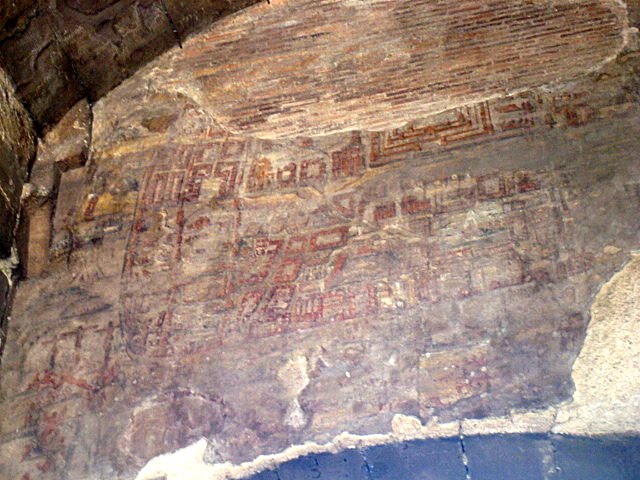Here's the reason why:
 |
| Golgotha in Christian Krulk van Adrichem's 1584 Map of Jerusalem. |
It is reproduced from the 1584 map of Jerusalem, by: Christian Krulk van Adrichem. It's a hand colored copperplate engraving---numerous copies exist.
Note Christ is both being nailed on the ground and suspended up in mid-air on a cross. His arms are put to the full stretch. Note also manner of dress of the locals: they are wearing robes turbans. Note also the city wall and the city of Jerusalem beyond: the wall corner is curved, and Jerusalem is an idealised garden city.
Now compare to the crucifixion scene fresco in the Flavian Ampitheatre (Roman Colosseum, or Coliseum):
First, the overview: note in the remainder of the fresco the curved corners of the depicted city wall of Jerusalem. Note, too, that the city of Jerusalem is depicted as a garden city. Now a close-up of the crucifixion scene at the northwest (lower-left) corner of the city:
 |
| Squalid Crucifixion scene - Flavian Ampitheatre - 80 or 1585 CE. |
Except for the extra squalor and the nude figure in the foreground depicted in this fresco, the scene looks uncannily like the Golgotha scene depicted in Christian Krulk van Adrichem's 1584 Map. Note how the freshly crucified person's the legs are bent and the arms extended just like in the 1584 map. The three figures on crosses, with the central one hidden by smoke from a fire based at the foot of the cross, are very similar to the depictions of Christ and the two thieves in Late Renaissance and Baroque art; the central figure even has his arms extended just like Christ's in the 1584 map. There is even a nude figure seated on a rock, approached by a person in a yellow tunic and black tights, similar to the person of Christ being offered wine in the 1584 map . Note also how the four crosses are depicted. In ancient Roman art, crosses and mobile poles are frequently depicted as merely lines, as seen in the Alexamenos, Puteoli and Vivat Crux graffiti, and in this illustration:
Note how the uprights, struts and handles of the mobile poles are shown only by lines. The crosses in the fresco are depicted like the ones in Mediaeval, Renaissance and Baroque art.
Now we can figure out if we have a clinch for a post-1584 provenance of this fresco or not. It depends on the mode of dress of the the person in yellow, and how Jerusalem is depicted. Is it typical of the First Century CE, or the Sixteenth, or later? First, the full image of Christian Krulk van Adrichem's 1584 Map of Jerusalem:
 |
| Christian Krulk van Adrichem's 1584 Map of Jerusalem. Source: Wikipedia Commons. |
We can see from the dress of the slaves sending condemned people to their deaths that their typical color of dress was red, not yellow. Note also they did not wear tights. And the typical Roman mode of dress in the street?
The Roman outfits are to the right of the image provided. Note the men are wearing leggings or sandals, not tights. And the outfits they wore, even those the lower-class male to the right, are draped, not blousy.
Now the woman's outfits.
Here, the women all are depicted with outfits that covered the whole body from neck to toe. They did not wear, as far as I know, skirts with hemlines at the knees. But it appears that lower-class women were not depicted! So I'll go with the men.
 |
| Source: Pinterest. |
 |
| Source: Kleanrite cleaners.com |




No comments:
Post a Comment